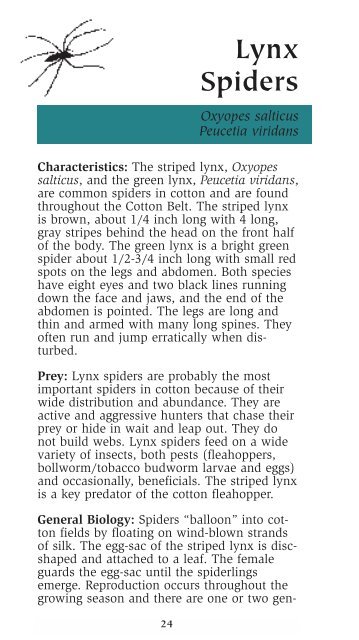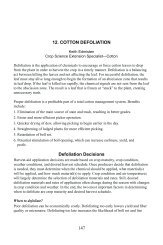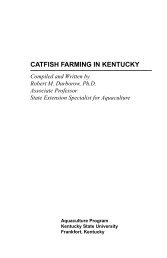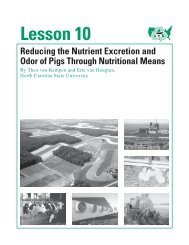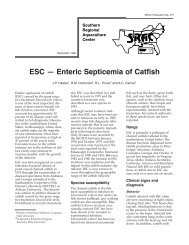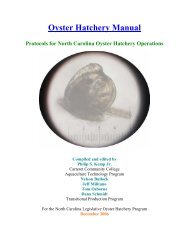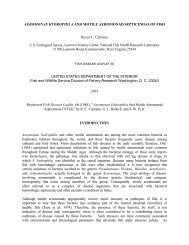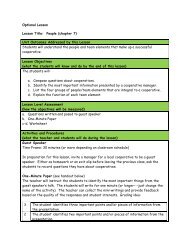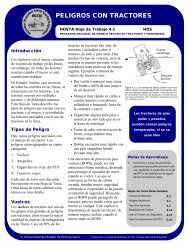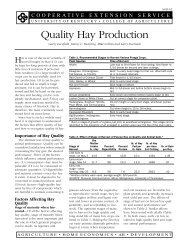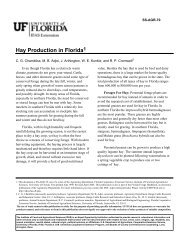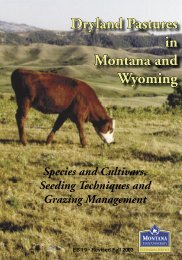Recognizing the Good Bugs in Cotton - Texas Is Cotton Country ...
Recognizing the Good Bugs in Cotton - Texas Is Cotton Country ...
Recognizing the Good Bugs in Cotton - Texas Is Cotton Country ...
Create successful ePaper yourself
Turn your PDF publications into a flip-book with our unique Google optimized e-Paper software.
24<br />
Lynx<br />
Spiders<br />
Oxyopes salticus<br />
Peucetia viridans<br />
Characteristics: The striped lynx, Oxyopes<br />
salticus, and <strong>the</strong> green lynx, Peucetia viridans,<br />
are common spiders <strong>in</strong> cotton and are found<br />
throughout <strong>the</strong> <strong>Cotton</strong> Belt. The striped lynx<br />
is brown, about 1/4 <strong>in</strong>ch long with 4 long,<br />
gray stripes beh<strong>in</strong>d <strong>the</strong> head on <strong>the</strong> front half<br />
of <strong>the</strong> body. The green lynx is a bright green<br />
spider about 1/2-3/4 <strong>in</strong>ch long with small red<br />
spots on <strong>the</strong> legs and abdomen. Both species<br />
have eight eyes and two black l<strong>in</strong>es runn<strong>in</strong>g<br />
down <strong>the</strong> face and jaws, and <strong>the</strong> end of <strong>the</strong><br />
abdomen is po<strong>in</strong>ted. The legs are long and<br />
th<strong>in</strong> and armed with many long sp<strong>in</strong>es. They<br />
often run and jump erratically when disturbed.<br />
Prey: Lynx spiders are probably <strong>the</strong> most<br />
important spiders <strong>in</strong> cotton because of <strong>the</strong>ir<br />
wide distribution and abundance. They are<br />
active and aggressive hunters that chase <strong>the</strong>ir<br />
prey or hide <strong>in</strong> wait and leap out. They do<br />
not build webs. Lynx spiders feed on a wide<br />
variety of <strong>in</strong>sects, both pests (fleahoppers,<br />
bollworm/tobacco budworm larvae and eggs)<br />
and occasionally, beneficials. The striped lynx<br />
is a key predator of <strong>the</strong> cotton fleahopper.<br />
General Biology: Spiders “balloon” <strong>in</strong>to cotton<br />
fields by float<strong>in</strong>g on w<strong>in</strong>d-blown strands<br />
of silk. The egg-sac of <strong>the</strong> striped lynx is discshaped<br />
and attached to a leaf. The female<br />
guards <strong>the</strong> egg-sac until <strong>the</strong> spiderl<strong>in</strong>gs<br />
emerge. Reproduction occurs throughout <strong>the</strong><br />
grow<strong>in</strong>g season and <strong>the</strong>re are one or two gen-


